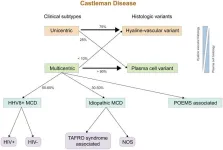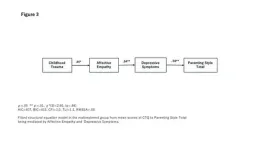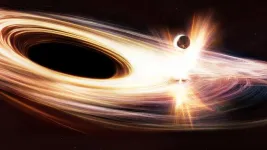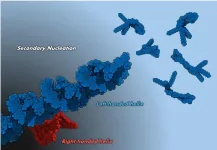(Press-News.org)
Castleman disease (CD) is a rare, non-clonal lymphoproliferative disorder that manifests with a wide range of histologic and clinical features. It is classified clinically into unicentric (UCD) and multicentric (MCD) forms and histopathologically into hyaline vascular (HV-CD), plasma cell (PC-CD), and mixed types. UCD typically presents as an isolated lymph node enlargement, often asymptomatic, whereas MCD involves multiple nodal sites and systemic symptoms. MCD may be associated with human herpesvirus 8 (HHV8), idiopathic origins (iMCD), POEMS syndrome, or TAFRO syndrome. Given its overlap with various reactive and neoplastic diseases, CD is diagnostically challenging and often mimicked by other conditions.
Histopathologic Features
HV-CD is marked by regressed germinal centers, concentric mantle zones ("onion-skinning"), and prominent sclerotic blood vessels, forming a "lollipop" appearance. The interfollicular regions show vascular proliferation and clusters of plasmacytoid dendritic cells.
PC-CD is characterized by interfollicular sheets of plasma cells and less prominent vascular changes. A third of these cases may show monotypic plasma cells, and overlap with HV features may be present.
Cytogenetics and Molecular Findings
Clonal cytogenetic abnormalities suggest a possible neoplastic origin in HV-CD, involving follicular dendritic cells. Key mutations in UCD include PDGFRB N666S, while iMCD is associated with mutations in NCOA4, SETD1A, and DNMT3A, among others. Dysregulation of genes involved in immune response, angiogenesis (e.g., CXCL13), and oxidative phosphorylation is noted, highlighting diverse molecular landscapes.
Diagnostic Criteria
Diagnosis relies on a combination of clinical, laboratory, and histological findings. HV-CD is defined by vascularized regressed follicles and fibrotic stroma. PC-CD diagnosis requires interfollicular plasmacytosis, polytypic or occasionally monotypic plasma cells, and exclusion of other conditions such as infections or autoimmune disease.
Mimickers of Castleman Disease
Numerous benign and malignant conditions can simulate CD:
・ Lymphomas: Follicular hyperplasia, follicular lymphoma, mantle cell lymphoma, and marginal zone lymphoma may resemble HV-CD. Angioimmunoblastic T-cell lymphoma (AITL) can mimic HV-CD due to similar vascular and plasmacytic features.
・ Classic Hodgkin Lymphoma (CHL): Particularly the interfollicular variant of CHL may overlap with PC-CD, making identification of Reed-Sternberg cells essential.
・ Follicular Dendritic Cell (FDC) Sarcoma: HV-CD often shows FDC proliferation, which can evolve into FDC sarcoma.
・ Plasma Cell Neoplasms: These can appear similar to PC-CD, especially when monotypic plasma cell populations are present.
・ IgG4-related Disease (IgG4-RD): Frequently overlaps with PC-CD and iMCD; differentiation requires histology, IgG4+/IgG+ plasma cell ratio, and clinical correlation.
・ Autoimmune Conditions: Rheumatoid arthritis, lupus, Still’s disease, and autoimmune lymphoproliferative syndrome (ALPS) can present with Castleman-like lymphadenopathy.
・ Infectious Causes: EBV, HHV8, HIV, CMV, and tuberculosis may cause lymph node changes similar to CD.
Associated Neoplasms
CD is linked to an increased risk of both hematologic and non-hematologic malignancies:
・ Plasma Cell Neoplasms: Especially within POEMS syndrome, characterized by polyneuropathy and monoclonal gammopathy.
・ Lymphomas: CD is associated with classic Hodgkin lymphoma, diffuse large B-cell lymphoma, mantle cell lymphoma, and peripheral T-cell lymphoma. These associations are often IL-6 driven.
・ Kaposi Sarcoma: Commonly seen in HHV8-positive MCD, often with concurrent HIV infection.
・ FDC Sarcoma: Can arise from HV-CD, supporting a neoplastic continuum from CD to malignancy.
・ Indolent T/B-Lymphoblastic Proliferation: Seen in CD with clusters of immature lymphoblasts that lack atypia and clonality, requiring careful immunohistochemical differentiation from leukemia/lymphoma.
Conclusions
Castleman disease encompasses a spectrum of histologic and clinical presentations, often overlapping with mimicking conditions. Accurate diagnosis requires a multidisciplinary approach integrating histopathology, molecular diagnostics, and clinical context. Recognizing mimickers and understanding associated neoplasms are essential for correct classification and management. Future studies focused on molecular pathogenesis may help refine the diagnosis and therapeutic strategies for CD and its related disorders.
Full text
https://www.xiahepublishing.com/2771-165X/JCTP-2024-00047
The study was recently published in the Journal of Clinical and Translational Pathology.
Journal of Clinical and Translational Pathology (JCTP) is the official scientific journal of the Chinese American Pathologists Association (CAPA). It publishes high quality peer-reviewed original research, reviews, perspectives, commentaries, and letters that are pertinent to clinical and translational pathology, including but not limited to anatomic pathology and clinical pathology. Basic scientific research on pathogenesis of diseases as well as application of pathology-related diagnostic techniques or methodologies also fit the scope of the JCTP.
Follow us on X: @xiahepublishing
Follow us on LinkedIn: Xia & He Publishing Inc.
END
Where does the deep sea begin? Definitions vary across science and legal frameworks. For the purposes of their joint analysis, the members of the European Marine Board’s (EMB) Deep Sea and Ocean Health Working Group defined the deep sea as the water column and seabed below 200 metres. Below this point, sunlight barely penetrates the water, and the habitat changes dramatically. According to this definition, the deep sea accounts for about 90 per cent of the ocean’s volume. Its importance for ...
Childhood maltreatment (CM) is a complex issue that is often passed on through generations. Studies have shown that parents who were abused as children may perpetuate a similar pattern of mistreating their children, creating a vicious cycle of abuse. A key factor in perpetuating this cycle is impaired empathy in parents who grew up in abusive environments. Simply put, parental empathy, the ability to understand and respond to children’s emotions, plays a critical role in effective parenting. In fact, children who experience abuse tend to have reduced empathy by the age ...
Quasicrystals (QCs) are fascinating solid materials that exhibit an intriguing atomic arrangement. Unlike regular crystals, in which atomic arrangements have an ordered repeating pattern, QCs display long-range atomic order that is not periodic. Due to this ‘quasiperiodic’ nature, QCs have unconventional symmetries that are absent in conventional crystals. Since their Nobel Prize-winning discovery, condensed matter physics researchers have dedicated immense attention towards QCs, attempting to both realize their unique quasiperiodic magnetic order and ...
Although we know that supermassive black holes (millions of times the mass of our Sun) lurk at the centre of most galaxies, their very nature makes them difficult to spot and study. In contrast to the popular idea of black holes constantly ‘gobbling up’ matter, these gravitational monsters can spend long periods of time in a dormant, inactive phase.
This was true of the black hole at the heart of SDSS1335+0728, a distant and unremarkable galaxy 300 million light-years away in the constellation of Virgo. After being inactive for decades, it suddenly lit up and recently began producing unprecedented flashes of X-ray light.
The first signs ...
Self-assembly or self-organization in molecular science refers to the phenomena where molecules spontaneously gather and form ordered structures, a unique property of materials used to develop optical and electronic materials. In a step towards fine-tuning this property, researchers from Japan successfully elucidated a technique where a small amount of residual aggregates drastically altered the self-assembly process of photo-responsive molecules. The research team was led by Professor Shiki Yagai from the Graduate School of Engineering, Chiba University, including Assistant Professor ...
CAMBRIDGE, MA -- Bacteria can be engineered to sense a variety of molecules, such as pollutants or soil nutrients. In most cases, however, these signals can only be detected by looking at the cells under a microscope or similarly sensitive lab equipment, making them impractical for large-scale use.
Using a new method that triggers cells to produce molecules that generate unique combinations of color, MIT engineers have shown that they can read out these bacterial signals from as far as 90 meters away. Their work could lead to the development of bacterial sensors for agricultural and other applications, which could be monitored by drones or ...
Capturing carbon dioxide (CO₂) from industrial emissions is crucial in the fight against climate change. But current methods, like chemical absorption, are expensive and energy-intensive. Scientists have long eyed graphene—an atom-thin, ultra-strong material—as a promising alternative for gas separation, but making large-area, efficient graphene membranes has been a challenge.
Now, a team at EPFL, led by Professor Kumar Agrawal, has developed a scalable technique to create porous graphene membranes ...
Researchers have developed a simple and cost-effective blood test capable of detecting Parkinson’s disease long before symptoms emerge, comparing the current state of diagnosing neurodegenerative diseases to the fight against cancer 50 years ago—when most cases were identified too late for effective treatment. The test quantifies specific RNA fragments in the blood, focusing on a repetitive RNA sequence that accumulates in Parkinson’s patients and a parallel decline in mitochondrial RNA, which deteriorates as the disease progresses. By measuring the ratio between these biomarkers, the test offers a highly accurate, non-invasive, rapid and affordable diagnostic tool, ...
A novel paper led by Dr Ulrich Brose of the German Centre for Integrative Biodiversity Research (iDiv) and the Friedrich Schiller University Jena is widening understanding of how species interact within ecosystems via the so-called “Internet of Nature.” Published in Nature Ecology and Evolution, the paper reveals that species not only exchange matter and energy but also share vital information that influences behaviour, interactions, and ecosystem dynamics – revealing previously hidden characteristics of natural ecosystems.
Traditionally, ecological studies have ...
Police officers are more than twice as likely to have traumatic brain injuries compared to the general population. Officers who incur these injuries while on duty face more than double the risk of developing complex post-traumatic stress disorder (PTSD).
That’s according to a new survey-based study from the University of Exeter, published in The Journal of Head Trauma Rehabilitation, which found a connection between traumatic brain injuries and PTSD in police officers. Authors say the findings ...





